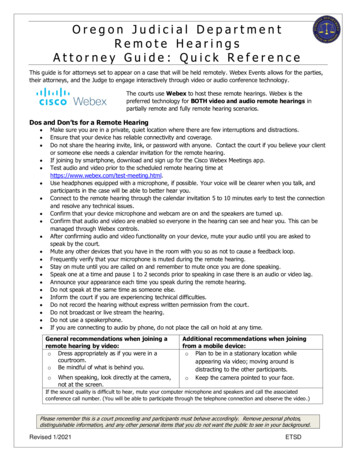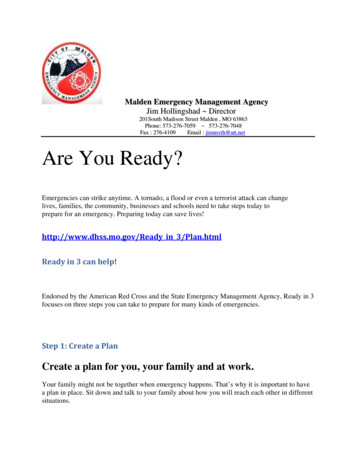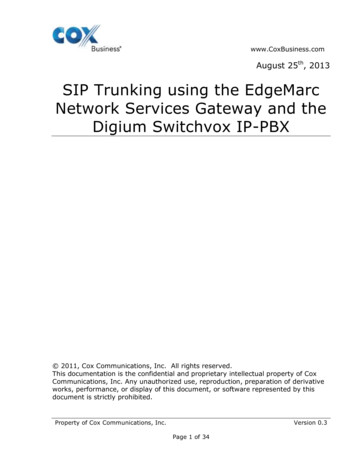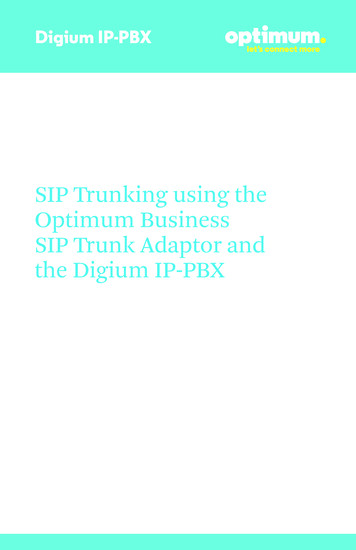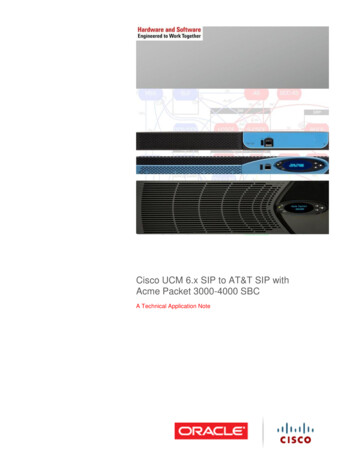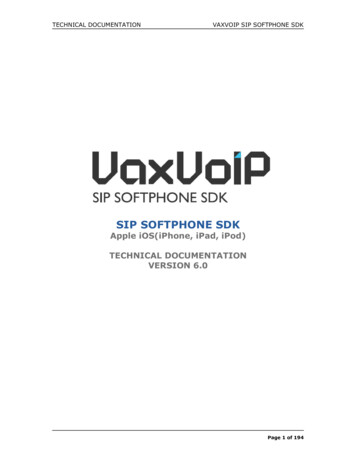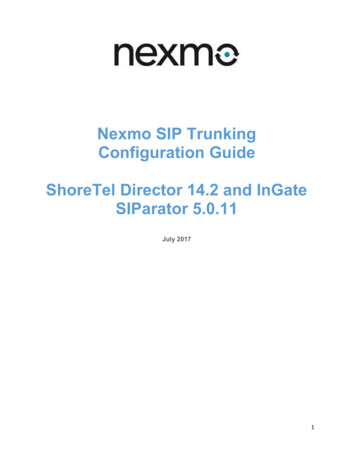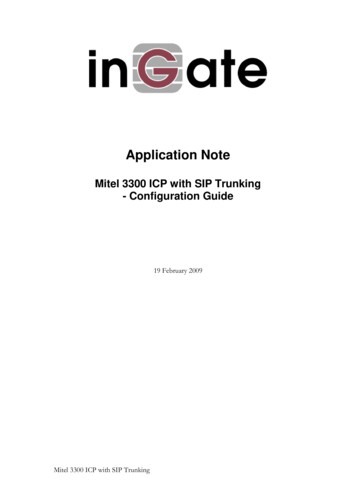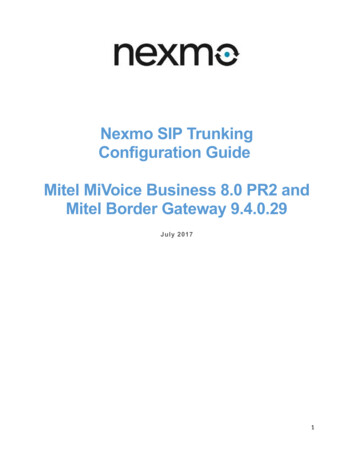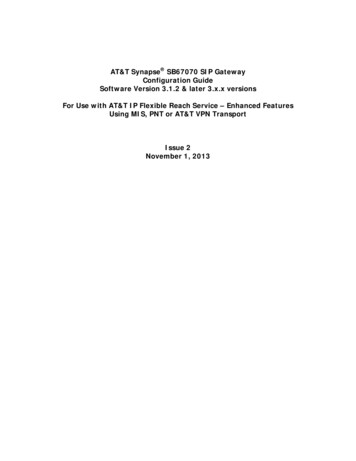
Transcription
AT&T Synapse SB67070 SIP GatewayConfiguration GuideSoftware Version 3.1.2 & later 3.x.x versionsFor Use with AT&T IP Flexible Reach Service – Enhanced FeaturesUsing MIS, PNT or AT&T VPN TransportIssue 2November 1, 2013
TABLE OF CONTENTS12Introduction . 3Special Notes. 32.1Emergency 911/E911 Services Limitations and Restrictions. 32.2Special Notes/Unsupported SIP Features . 33Overview . 43.1SB67070 SIP Gateway Features . 53.2Tested Components . 53.3Call Flow . 64Configuration Guide . 74.1Software Version Compatibility . 74.2Configuring Synapse for IP Flexible Reach Service . 84.2.1Logging In to Synapse as Administrator. 84.3Configuring the SIP Gateway . 94.4Configuring the Dial Plan. 125Troubleshooting . 145.1Device Log. 145.2General Troubleshooting Topics . 15Page 2 of 16
1 IntroductionThis configuration guide provides instructions for configuring the Synapse Business PhoneSystem for AT&T IP Flexible Reach SIP Trunking Service. Specifically, this guide describeshow to configure the Synapse SB67070 SIP Gateway for IP Flexible Reach Service.The SB67070 SIP Gateway was qualified for AT&T IP Flexible Reach Service using Synapsesoftware version 3.1.2, and covers all later 3.x.x versions.Documents related to this configuration guide include: Synapse Installation Guide i23 or later Synapse Administrator’s Guide i22 or laterYou can view and download these documents from www.telephones.att.com/synapseguides.2 Special NotesThis section describes limitations and special considerations when using the SynapseSB67070 SIP Gateway with the IP Flexible Reach Service.2.1 Emergency 911/E911 Services Limitations and RestrictionsAlthough AT&T provides 911/E911 calling capabilities, AT&T does not warrant or representthat the equipment and software (e.g., IP PBX) reviewed in this customer configurationguide will properly operate with AT&T IP Flexible Reach to complete 911/E911 calls;therefore, it is the Customer’s responsibility to ensure proper operation with itsequipment/software vendor.While AT&T IP Flexible Reach services support E911/911 calling capabilities under certainCalling Plans, there are circumstances when that E911/911 service may not be available, asstated in the Service Guide for AT&T IP Flexible Reach found athttp://new.serviceguide.att.com. Such circumstances include, but are not limited to,relocation of the end user’s CPE, use of a non-native or virtual telephone number, failure inthe broadband connection, loss of electrical power, and delays that may occur in updatingthe Customer’s location in the automatic location information database. Please review theAT&T IP Flexible Reach Service Guide in detail to understand the limitations and restrictions.Note: N11 (including 911) calls are not supported unless AT&T IP Flexible Reach LocalService is ordered.2.2 Special Notes/Unsupported SIP Features Passing Calling Number marked private T.38 fax machines SIP Diversion information. Call forwarding is supported within the Synapse PBX. CallerID information for the forwarded call is not retained. The caller does not receive anindication that the call was forwarded. Transferred calls will be looped through the Synapse IP PBX for the duration of the calland will occupy two trunks. Synapse does not use SIP REFER to handle transferred calls. RTCP Sender Report is not supported Negotiated ptime 20Page 3 of 16
For the Network-Based Locate Me feature (aka Sequential Ringing), the AnswerConfirmation option must be set to OFF. Sequential Ringing does not work if AnswerConfirmation is turned ON. Note: This is specific to Sequential ringing. AnswerConfirmation can be turned ON for the Simultaneous ringing feature.3 OverviewThis configuration guide assumes that your Synapse system is installed and that users areable to make internal (Deskset to Deskset) calls. A Synapse System must include one ofmore of the following devices: Desksets (SB67030/031 and/or SB67020/025 Desksets). The system supports up to100 Desksets. Gateways. At least one Gateway must be installed. The system supports up to fourSB67010 PSTN Gateways, one SB67060 T1 Gateway, and one SB67070 SIP Gateway.You can install any combination of Gateway models in a system, as long as you do notexceed the supported number of each Gateway model.For more information, see Figure 1: Sample Synapse System.Figure 1: Sample Synapse SystemPage 4 of 16
3.1 SB67070 SIP Gateway Features A LAN 10/100 BaseT Ethernet port connects to the existing Synapse network. A four-line LCD display with four hard keys provides status information, such as thedevice IP address, and allows basic network configuration and firmware upgrades. Device configuration and system configuration, such as SIP Account information,available through the Web User Interface (WebUI). Supports up to 16 simultaneous voice calls. Additional System features, including Direct Inward Dial (DID) and configurable dialplan.For more information about Synapse, visit http://telephones.att.com/smb.Figure 2: SB67070 SIP Gateway Front Panel3.2 Tested ComponentsAll Synapse Desksets and Gateways must be running the same software versions (3.1.2 orlater 3.x.x versions).Page 5 of 16
3.3 Call FlowInbound Call Flow:1. A PSTN phone originates a call to an AT&T IP Flexible Reach service number.2. The PSTN routes the call to the AT&T IP Flexible Reach service network.3. The AT&T IP Flexible Reach service routes the call to Synapse System at Customer Site.4. Synapse System applies any necessary digit manipulations based upon the DID androutes the call to a hunt group, phone or a fax endpoint.Outbound Call Flow:1. Synapse System phone or fax endpoint originates a call for delivery to AT&T IP FlexibleReach service network.2. Synapse System applies any necessary origination treatment (verifying permissions,determining the proper route, selecting the outgoing trunk, etc.) and routes the call toAT&T IP Flexible Reach service network.3. The AT&T IP Flexible Reach service network delivers the call to PSTN.4. PSTN delivers the call to a phone or fax endpoint.Deskset-to-Deskset Call Flow: A Synapse Deskset originates a call to a 2nd Deskset by using an extension number.The call is routed based on internal signalling within the Synapse System. This doesnot occupy any trunk. A Synapse Deskset originates a call to a 2nd Deskset by dialing a 10/11-digittelephone number. The call is routed through the Outbound Call Flow (describedabove) and the Inbound Call Flow (described above) and then reaches the 2ndDeskset based upon DID. This occupies two trunks for the whole duration of the call.Page 6 of 16
4 Configuration GuideThis section describes how to configure the SIP Gateway Account Settings to support AT&T’sIP Flexible Reach Service.4.1 Software Version CompatibilitySystems with software versions 3.1.2 and later 3.x.x versions support the featuresdescribed in this guide. All Gateways and Desksets must have the same software versionsinstalled. To determine the software version of the SB67070 SIP Gateway from the device frontpanel, press SELECT, SELECT, and then DOWN. The software version appears. To determine the SB67020/025 Deskset software version, press MENU, then 4, andthen to display the software version. To determine the SB67030/031 Deskset software version, press MENU, then 4. Seethe P Firmware version.To determine the software version of all installed devices, log in as administrator. See“Logging In to Synapse as Administrator” on page 8. Then click Detailed Site Informationto see the software versions and other information. There may be a delay as the systemgathers this information.To update device software, see “Updating Devices” in the Synapse Administrator’s Guide,available at www.telephones.att.com/synapseguides.Page 7 of 16
4.2 Configuring Synapse for IP Flexible Reach ServiceThe Synapse WebUI allows you to configure the SIP Gateway for IP Flexible Reach Service.4.2.1 Logging In to Synapse as AdministratorTo access the Synapse WebUI and log in:1. Connect your computer to the same IP subnet as the Synapse system, or ensure thatdevices on different subnets are able to communicate. For example, you can connectyour computer to the PC port on the back of a Deskset.2. On the Deskset, press MENU then 4. The Deskset Information screen appears.3. Find the IP address on the Deskset Information screen.4. Open a browser. Depending on your browser, some of the pages presented here maylook different and have different controls.5. Type the Deskset IP Address in the browser address bar and press Enter. The Login pageappears.6. Enter your login credentials. If logging in for the first time, enter admin in the LoginName field and 12345 in the Password field, then click Login. You can change yourAdmin ID and password once you are logged in.7. Click topics from the navigation list on the left side of the WebUI to see them. For yoursecurity, the WebUI times out after being idle for 10 minutes, after which you must login again.Page 8 of 16
4.3 Configuring the SIP GatewayTo configure the SIP Gateway General Settings:1. In the navigation menu at left, click SIP Settings and then click SIP General Settings.The SIP General Settings page appears.2. Enter the Starting RTP Port number. AT&T IP Flexible Reach supports an RTP portrange between 16384 and 32767. Ensure that the RTP port setting is within that range.3. Click Apply to save your changes.Page 9 of 16
To configure SIP Account Settings:1. In the navigation menu at left, click SIP Account Settings. The SIP Account Settingspage appears.2. Select SIP Trunking as the Account Type.3. Select Create New Account, or select an account to edit. If you have already createdan account, a Delete Account button appears. Clicking Delete Account deletes theaccount and loads an empty account page.4. Enter the SIP Gateway Basic Settings.a. Enable or Disable the account. You must enable the account before it can beused. Disabling the account does not erase the settings associated with theaccount.Page 10 of 16
b. Enter the Account Name. The SIP account name appears on the Dial PlanSettings page and the Trunk Reservation page.c. For Max Calls, enter the number of simultaneous call sessions youpurchased. The maximum value is 16. Setting the Max Calls to a value that isless than the current number of Trunk Reservations for the SIP Account willgenerate an error.d. Enter the Display Name. The Display Name is the text portion of the CallerID that is displayed for outgoing calls.e. Enter the User Name as provided by AT&T. The User Name, also known asthe Account ID, is usually the company's main number. Synapse will onlyaccept digits for a User Name.f.Leave the Auth User Name and Auth User Password fields blank.g. Enter the Primary Number. Usually this is the same as the main phonenumber as entered under User Name.h. Set the IP-PBX Signaling Address to Enabled.5. Enter the SIP Gateway Account Registration Settings.a. Select Static Registration.b. Enter the number of seconds for Registration Expires. This setting applies todynamic registration. It is a re-registration timeout value sent to the SIPProvider. This is usually overriden by a re-registration interval determined bythe service provider’s response. The default setting is 3600 seconds andshould only be changed on the advice of your service provider.6. Enter the SIP Gateway Account Server Settings.a. Enter the SIP Server Address or URL.b. If necessary, enter the SIP Server Port. Port 5060, the default setting, istypically used for SIP transmission.c. Enter the Registrar Server Address or URL if it is different than the SIPServer Address or URL.d. Enter the Registrar Server Port if it is different than the SIP Server Port. If aRegistrar Server address or URL is entered in the field above, it may not benecessary to enter a Registrar Server Port.e. Enter the Outbound Proxy Server Address or URL if it is different than theSIP Server Address or URL.f.Enter the Outbound Proxy Server Port if it is different than the SIP ServerPort. If an Outbound Proxy Server address or URL is entered in the fieldabove, it may not be necessary to enter an Outbound Proxy Server Port.7. Configure the Codec Configuration.a. Enable or disable audio codecs. You can click Add to add the selected codecto the Enabled Codecs list, or click Remove to add it to the DisabledCodecs list.Page 11 of 16
b. Arrange the enabled audio codecs. Select a codec, then click or tochange the order. AT&T IP Flexible Reach requires G.729 to be the primarycodec, with G.711u as the secondary codec.8. Click Apply to save your changes.The SIP Gateway Registration LED should turn green when the SIP Gateway hassuccessfully registered to AT&T IP Flexible Reach Service.4.4 Configuring the Dial PlanBefore configuring the Dial Plan, see “Dial Plan Settings” in the Synapse SystemAdministrator’s Guide i15 or later available at http://telephones.att.com/synapseguides.To configure Synapse Dial Plan settings:1. In the navigation menu at left, click Dial Plan Settings. The Dial Plan Settings pageappears.2. Set the Default Routing Priority. Ensure that the AT&T IP Flexible Reach Service SIPAccount that you configured is included in the priority list. You can: exclude a trunk by selecting it, then clicking Remove. You may want to exclude atrunk if it is being used for a fax line or a door phone line, for example.Page 12 of 16
move a trunk up or down the priority list by selecting it, then clicking or .3. Set the Call Log/Messages Prefix according to your Dialing Rules. You can enter amaximum of eight digits using only the characters 0–9, #, *, or P. Leave the field blankif the Dialing Rules do not use a number for external line access.4. Enter or modify Dialing Rule patterns. For more information, see “About Dialing Rules” inthe Synapse System Administrator’s Guide.5. Select a Route for each Dialing Rule pattern as required. The list of routes includes allavailable trunks in the system, as well as the Default Routing Priority. You can route aDialing Rule pattern to use the SIP Gateway only, or to use the Default Routing Priority.6. Click Apply to save these settings.Page 13 of 16
5 TroubleshootingNote: For customer service, repair, replacement, or warranty service, and all questionsabout this product, visit our web site at www.telephones.att.com/smbor call 1 (888) 916-2007. In Canada dial 1 (888) 883-2474.5.1 Device LogIf you have trouble with your system and you require customer service, they may need thedevice log for troubleshooting purposes. You can generate a device log on the Device Log page.You can also configure a device log prior to generating the log. Your Synapse ProductSupport specialist may want to see specific information in the device log. If so, you mustconfigure the device log using a configuration file that your Synapse support personprovides.To configure the Device Log:1. In the navigation menu at left, click Device Management, then Device Log.2. In the Device Log list, select the desired device.3. Under Configure Device Log, click Browse. and select the Device Log Configurationfile.4. Click Configure Device Log. After configuration is complete, you can proceed withgenerating the Device Log, as described below.To generate the Device Log:1. In the navigation menu at left, click Device Management, then Device Log. TheDevice Log page appears.2. In the Device Log list, select the desired device and click Save Device Log.3. It takes a minute for the file to generate. A pop-up box then asks you where to save thefile on your computer.After the download is complete you should provide the file to the installer or customerservice.Page 14 of 16
5.2 General Troubleshooting TopicsSIP Gateway REG LED is RED or SIP Registration status on the WebUI is Unknown.CauseActionIncorrect SIP account settings.Make sure your SIP Account settings are setas per your SIP service provider’srequirements.Network connection problems.Make sure you have a reliable Internetconnection for the SIP Gateway.Make sure the SIP service is not down.SIP Gateway is not working.CauseActionNo power to the Gateway.Check the front panel LEDs on the Gateway:Make sure the Power LED is on. If not,connect power to the Gateway.Make sure that the SYN/ACT andREGISTRATION LEDs are both on solidGREEN.Incorrect SIP account settings.Make sure your SIP Account settings are setas per your SIP service provider’srequirements.Network connection problems.Make sure the SIP Gateway is synchronizedto the system. Check the WebUI DetailedSystem Information page.Make sure you have a reliable Internetconnection for the SIP Gateway.Make sure the SIP service is not down.Page 15 of 16
Calls on the SIP Gateway terminate unexpectedly.CauseActionIssues with SIP account settings.Make sure that your SIP account isregistered. The REGISTRATION LED on theSIP Gateway front panel should be solidGREEN and the Registration Status on theWebUI SIP Account Settings should showRegistered.On the WebUI SIP Account Settings page,ensure Static Registration is not selected.Incorrect SIP account settings.Make sure your SIP Account settings are setas per your SIP service provider’srequirements.Network connection problems.Make sure the SIP Gateway is synchronizedto the system. Check the WebUI DetailedSystem Information page.Make sure you have a reliable Internetconnection for the SIP Gateway.Try port forwarding on the router, the portspecified for the SIP Server to the SIPGateway LAN address.Make sure the SIP service is not down.Calls on the SIP Gateway have intermittent audio.CauseActionToo many simultaneous calls approaching orexceeding available network bandwidth.Enable G.729 codec, or give G.729 priorityover G.711.Increase network bandwidth to allow for themaximum number of simultaneous calls youhave purchased.Calls on the SIP Gateway have one-way audio.CauseActionIncorrect LAN configuration.Check your LAN configuration for theGateway. We recommend using the IPsubnet 192.x.x.x.Page 16 of 16
The SIP Account Settings page appears. 2. Select SIP Trunking as the Account Type. 3. Select . Create New Account, or select an account to edit. If you have already created an account, a . Delete Account. button appears. Clicking . Delete Account. deletes the account and loads an empty account page. 4. Enter the SIP Gateway Basic Settings. a.File Size: 429KB


